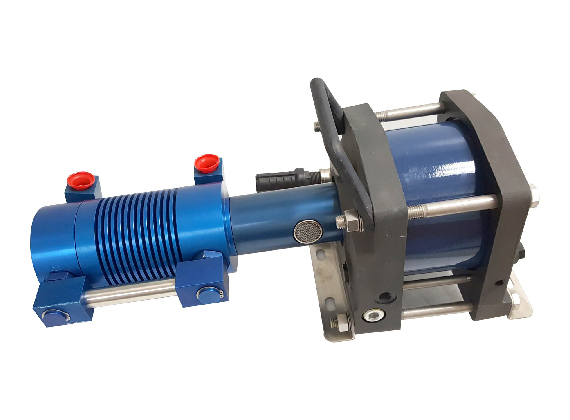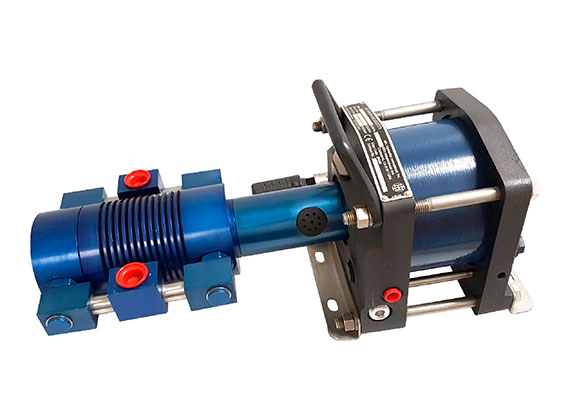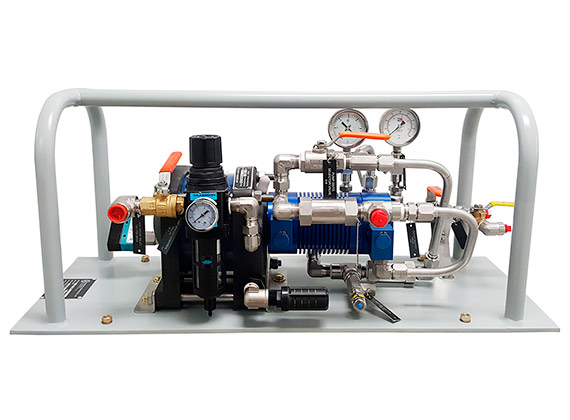Official distributor in Russia and CIS countries
Pumps and compressors for pumping CO2 carbon dioxide
Carbon Dioxide Boosters - Application
1. Pressure liquefaction.
Gas compressors and pump compressors are successfully used to liquefy CO2 in the subcritical area for exhaust gas recovery after the reactor.
It is also physically possible to squeeze carbon dioxide residues from the emptied cylinder into the filled one in order to save gas, but this is not economically justified - the cost of operating the compressor will exceed the benefit of saving CO2 gas residues based on its market value.
Liquid plunger pumps are categorically unsuitable for this task.
2. Polystyrene foam extrusion.
Compressor pumps are HII used to increase the available cavitation margin upstream of the metering three-plunger pump to power the extruder.
The best solution is to use an explosive decompression resistant pump compressor.
It is also allowed to use a gas compressor in a design resistant to explosive decompression.
Gas is supplied from a 20 cc tank at a temperature of -19C, pressure of 20 bar, where it is in the liquid phase.
In the process of transporting CO2 from the tank to the compressor pump, the fluid is heated and part of the liquid phase boils, the boiling phase mixture comes to suction in an approximate ratio of 50% to 50%.
When carbon dioxide is compressed in the compressor working chamber, the gas phase is liquefied by pressure, the available cavitation margin at the inlet to the metering three-plunger pump increases, which ensures its stable operation.
The use of plunger pumps to solve this problem is theoretically possible, but it is practically necessary to install a refrigerator or compressor directly at the pump inlet. Otherwise, a gas cushion is formed in the working chamber of the plunger pump, which the plunger is unable to pump.
Practice shows that the economic effect of using a pump instead of a compressor for this task is completely offset by solving the problems of boiling the liquid phase.
Carbon dioxide is significantly different from freons, which do not have problems due to higher boiling points and greater gas stability.
3. Subcritical and supercritical CO2 extraction of plant raw materials
Gas compressors are recommended for supercritical extraction. Explosive decompression protection is not required provided that there are no gas-liquid-gas phase transitions at all stages of the equipment operation.
In the case of subcritical extraction, liquid pumps can be used - they are practically not subject to explosive decompression. It is also possible to use pump compressors and gas compressors in a design resistant to explosive decompression.
4. Filling of carbon dioxide fire extinguishing modules
Compressors and pump compressors will accelerate the supply of carbon dioxide to the module and allow to refuel the nitrogen-charged module by mass when CO2 leaks.
Explosive decompression with carbon dioxide and control techniques.
Boiling carbon dioxide has excellent blowing properties.
This remarkable feature of carbon dioxide has been widely used in extrusion lines, replacing freons and other expensive blowing gases.
Similar to foaming, carbon dioxide polystyrene successfully foams the piston and compressor rod seals into a sponge.
Description of the explosive decompression process:
In the liquid phase, with excellent permeability, CO2 penetrates the pores of seals.
With relatively fast boiling, CO2 increases dramatically in the pores of the compaction, and the compaction foams.
Seal failure occurs instantaneously.
To combat explosive decompression, manufacturers use special seals resistant to carbon dioxide. However, the use of special seals does not guarantee 100% protection against explosive decompression.
The proper depressurization mode from the system must be ensured.
CO2 critical point, substance condition and selection of pumping equipment
It is known from reference literature that the critical point for carbon dioxide corresponds to a temperature of 31.1 C (304.2 K); 73.8 bar g
At this point, the density of the medium in the liquid and gas phases becomes equal, the surface tension of the liquid phase becomes zero, the interface between the liquid phase and the gas phase (substance vapors) disappears.
The state of the substance determines the temperature, not the pressure.
An example of supercritical media is air, nitrogen, oxygen under normal conditions - in everyday view, these are gases that cannot be transferred to the liquid phase under any pressure. In terms of thermodynamics, these are supercritical fluids.
Let's look at different cases.
Case 1: 31.1 C and above, pressure below 73.8 bar.
The temperature of carbon dioxide in this case is in the supercritical region, the pressure is below the critical region.
Phase State: Gas
Substance state: supercritical fluid
When the pressure decreases, the density of the substance decreases and it becomes lower than it would have been if the substance had been in a liquid state at the same pressure.
Household example: the density of water vapor in the sauna at atmospheric pressure is much lower than the density of boiling water in the kettle.
Case 2: temperature 31.1 C and above, pressure equal to or higher than 73.8 bar.
Phase State: Gas
Substance state: supercritical fluid
Please note that no matter how much pressure you compress carbon dioxide at temperatures above 31.1 C, you cannot obtain a liquid phase.
The density of the gas phase is equal to the density of the imaginary liquid phase at the same pressure over the entire pressure and temperature range.
Case 3: carbon dioxide temperature -56.6 to C + 31.1 C.
State of matter: subcritical fluid
Phase state: defined by the CO2 boiling curve.
Case 3.1. The temperature of the fluid determines the boiling point of CO2, the pressure is equal to the boiling pressure.
Phase state: liquid with gas phase vapors.
This is the most common case - carbon dioxide is in a liquid state and is constantly boiling, the pressure in the container is maintained by carbon dioxide vapors and is unchanged at this temperature.
When the temperature changes, the pressure in the container changes accordingly.
Venting gas from the vessel leads to thermodynamic cooling and a corresponding pressure drop.
The phase boundary corresponds to the saturated vapour pressure level and is the zero mark when determining the cavitation margin.
The available cavitation margin is measured in meters of liquid column and is deposited down from the interface to the liquid pump nozzle.
The higher the numerical value of the cavitation margin, the more stable the liquid pump is.
This is not relevant for gas compressors.
Case 3.2. The temperature of the fluid determines the boiling point of CO2, the pressure is below the boiling pressure.
Phase State: Gas
The case corresponds to an empty cylinder (vessel) with gas residues.
In the subcritical area, the gas phase can be liquefied by pressure using a compressor. Remember that during gas compression and liquefaction, a significant amount of heat is generated, which shifts the boiling point towards high pressures and approaches the + 31.1 C critical point - the supercritical region.
Heat must be removed during liquefaction.
Case 3.3. The temperature of the fluid determines the boiling point of CO2, the pressure is higher than the boiling pressure.
Phase state: liquid
The case corresponds to a charged fire extinguishing module with a nitrogen cushion or vessel, such as a chemical reactor fully filled with liquid carbon dioxide hydraulically compressed with a high pressure pump.
An increase or decrease in pressure by direct injection of the liquid phase of CO2 without phase transition occurs with an extremely slight increase or decrease in carbon dioxide temperature.



